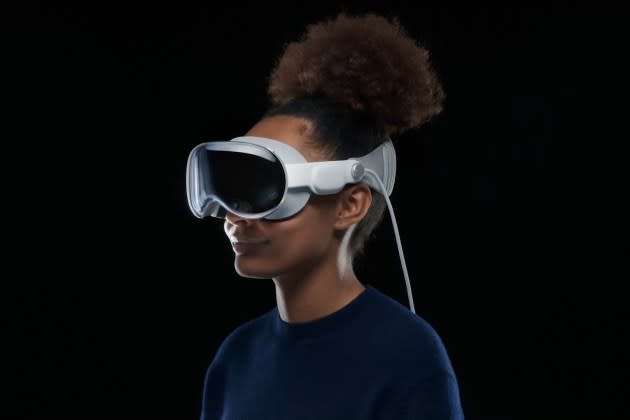What to Watch: Augmented Reality’s Getting Real

Today’s augmented reality is undeniably a creature of the web, a tech typically defined by social media lenses, Zoom effects, virtual product try-ons and other fun or useful visual mirages. But those digital bedazzlements are making moves to break out of the online space and into the real world, experts told WWD.
According to Diego Di Tommaso, chief operating officer and cofounder of AR metaverse platform Over, there’s more energy in the space since Apple unveiled the Vision Pro in June. He credits the device, which will release in early 2024, for raising the profile of AR and spatial computing, and he expects brands to take those cues into new territory, including physical locations.
More from WWD
5 Essential Facts for Fashion About EU's Digital Services Act
What to Watch: The Continued Rise of Wearable Wellness Devices
“In the next six to 12 months, we expect AR adoption by brands to exist mainly around bricks-and-mortar activations,” he told WWD. “[That means] either integrating an augmented reality experience into the exterior of stores, such as Pull & Bear, or including an interior element, like try-ons or product augmentation — anything that can drive people into stores.”
With that framework, any location can be a store. This may benefit brands with strong online followings in particular, because they could leverage that popularity by beaming a store-like experience with avatars right into shoppers’ homes, he added.
In September, Over will team with Pinko on an AR activation at a pop-up store in Florence’s Rinascente building. Though it’s still a little early, the Italian fashion company told WWD, “it will feature exterior and interior AR experiences, including interactive digital products, to drive awareness of a new sustainable product line for the brand.”
AR’s expansion in the real world is part of a broader push under a so-called “phygital” movement.
The label gained traction as a reference to omnichannel retail, as an effort to join physical and digital shopping, but eventually expanded to cover the virtual world as well. Elements that fall under this umbrella include digital-physical “twinning,” for instance, which refers to virtual products such as AR assets, avatar wear and other digital collectibles that come with a physical version. Now it encompasses more than just individual products or bridging e-commerce and brick-and-mortar strategies. It’s about entire pillars of experience, and how technology in one category can support others.
According to Andrea Abrams, founder and chief executive officer of Phygicode, a consortium dedicated to advancing phygital products and experiences, 2024 will be the year of “true immersion,” thanks to spatial computing, and her group wants to pave the way for this coming shift in experiences. In the fourth quarter, the group plans to launch an extension called Phygicode Lab, “a new, programmatic approach to tech adoption, focused on using spatial web tools such as augmented reality to enhance product and experiences,” Abrams said.
The initiative fits into a vision of spatial or ambient computing that has enraptured Silicon Valley for years. Abrams summed it up as “transferring interaction with technology away from screens and into physical spaces.” Users won’t be glued to those black, rectangular screens anymore, but speak out loud, hear or view useful data as part of their environment, use gestures to accomplish tasks and more. Anyone who has ever spoken to a smart speaker and asked Alexa, Siri or Google Assistant for traffic reports or to shut off lights has experienced it, whether they realized it or not.
Apple chief executive officer Tim Cook nodded to spatial computing, when he described the Vision Pro as “the first product you look through, not at.”
Giovanna G. Casimiro, who recently left Decentraland to join Phygicode as its head of production, has worked with AR for more than a decade, and she believes that now is an exciting time for the space. “We are seeing that greater adoption of immersive technologies is starting to involve truly ‘phygital’ product and experiences,” she said.
Casimiro noted there has been three decades of development in extended realities like AR, virtual reality and mixed reality, but she expects the current transition to “phygitality” to be more immersive.
For retail, Phygicode’s goal in the spatial web isn’t to replace physical stores with virtual experiences. On the contrary, the group wants to use virtual tech like AR to “bring people back to the malls and entertainment centers, to expand and accentuate their relationships with products and activities,” Abrams said.
Another aspect of AR could help the cause — the overlap between AR and artificial intelligence. Over’s Di Tommaso noted that, with AI’s rapid and extraordinary advancements, “you could see virtual shop assistants with your measurements popping up in your living room to showcase the latest collections, making note of your likes, dislikes and preferences.”
That’s not a theoretical musing, but “something Over is working toward with our own AI-powered avatars,” he added. Of course, he’s most bullish about implications for his own AR metaverse. He believes that such shared spaces for AR will be more commonplace at major fashion weeks, similar to Over’s AR fashion show in Milan in March.
Of course, it will take more than a single quarter to deliver on all of these areas. But the tech-makers and groups behind them believe these scenarios are within reach — which means, as the egg nog and holiday promotions flow in the coming quarter, so will the Red Bull and coffee behind the scenes, as the ground gets broken on the next iteration of AR in retail.
Best of WWD
